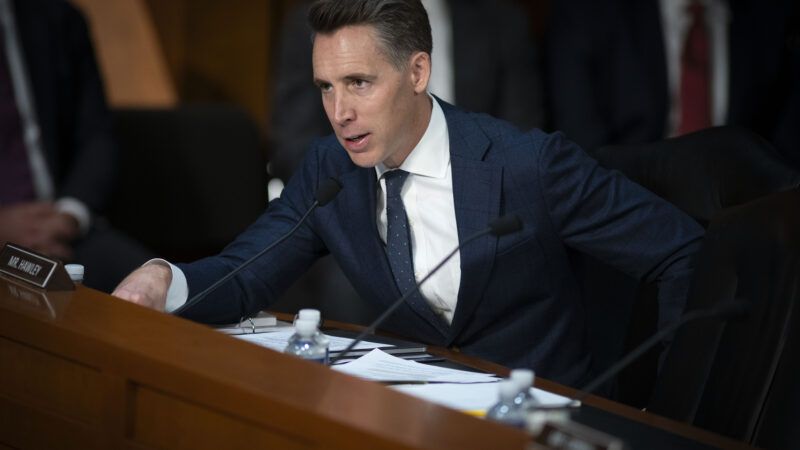How Josh Hawley Is Empowering Unions in New York and California
Some blue states are trying to set up their own versions of the NLRB, and Hawley is inadvertently (or deliberately) helping the cause.

When Sen. Josh Hawley (R–Mo.) clashed with a Boeing attorney at a committee hearing earlier this month, he was clearly picking sides in an ongoing fight between the company and thousands of striking workers at a Missouri factory.
But Hawley wasn't just borrowing the labor union's rhetoric as he criticized Boeing's CEO's pay and demanded "fairness" for the workers. As a result of that hearing, Hawley has directly (if perhaps incidentally) empowered labor unions in New York and California, who will find friendlier turf for labor disputes while the National Labor Relations Board (NLRB) continues to lack a quorum.
Here's why: New York and California have recently created state-level entities that are meant to serve the same purpose as the NLRB, which was created in 1935 to adjudicate disputes between unions and employers. The creation of those state-level entities has been backed by labor unions as a way to "circumvent" the Trump administration's expected appointment of less labor-friendly members to the NLRB, as Politico explained last month.
It's not clear whether those states can legally do that, and the NLRB has already sued New York on the grounds that a state-level labor board undermines the "core jurisdiction" of the federal board.
For now, the laws authorizing the New York and California boards allow those entities to operate only while the NLRB is inactive—which it currently is, because it does not have enough members.
That's where Hawley enters the picture.
Scott Mayer, the Boeing attorney who drew Hawley's ire at that October 3 hearing, was one of three people picked by President Donald Trump to fill vacancies on the NLRB. At the hearing, Mayer reminded Hawley that he was not sitting before the Senate as a representative of Boeing and pointed out that both the company and the striking workers were negotiating towards a new contract.
That didn't slow Hawley down. Hawley pushed for a "fair" resolution to the labor dispute between Boeing and members of the International Association of Machinists and Aerospace Workers, which represents workers at a factory in Missouri that produces fighter jets.
"With 3,000-plus members of residents in my state on strike, unable to work, unable to get health care, while your CEO is getting paid $30-some million," Hawley said, while tag-teaming Mayer with Sen. Bernie Sanders (I–Vt.).
A week later, the Senate Health, Education, Labor and Pensions Committee voted to confirm two of Trump's NLRB nominees. Mayer's nomination was tabled.
Without that seat filled, the NLRB still lacks a quorum—and, as a result, the labor boards in New York and California have power.
Of course, blocking Mayer's appointment to the board is within Hawley's authority as a senator and a member of that key committee. Still, exercising that authority has opened Hawley to criticism.
"Hawley is definitely trying to help unions," Sean Higgins, a research fellow at the Competitive Enterprise Institute, a free market think tank, told Reason via email.
Higgins attributes Hawley's recent actions to politics rather than policymaking. By aligning with unions, Hawley thinks he can "peel them away from the Democrats. Or at least put them in play politically."
Hawley's office did not return requests for comment.
It's true that the Trump era has brought a shift in union politics and potentially created an opportunity for Republicans to exploit. But if there is a lesson to be gleaned from Trump's success with rank-and-file union members, it seems to be that Republicans can peel those voters away by speaking directly to them on a cultural level, rather than by echoing labor union talking points. Trump didn't win by promising union bosses that he'd appoint friendly bureaucrats in key positions, after all. Quite the opposite.
Politics aside, the policy consequences of Hawley's tiff with Mayer seem clear: labor unions in New York and California have more power to flex—at least until those entities are ruled illegal by the courts or until the NLRB gets a quorum again.
That sort of ad hoc federalism might be preferable to having a single federal entity setting labor law for everyone—although Higgins, no fan of the NLRB, also warns that it could create labor law chaos and lots of headaches for employers operating in multiple states. Any positive, federalist outcomes for workers would hinge on the NLRB being permanently shut down by Congress. Otherwise, it would simply come back into power when the next labor-friendly administration takes over.
In some ways, this fight over the NLRB mirrors the concurrent battle over the ongoing government shut down. In both cases, the temporary hobbling of federal authority is not actually reducing the size or power that the government has over anyone—but is merely channeling that power through new directions.
In Hawley's case, he is channeling that power in an unusual way: Away from Trump's hand-picked nominee and towards blue-state labor unions.


Show Comments (8)